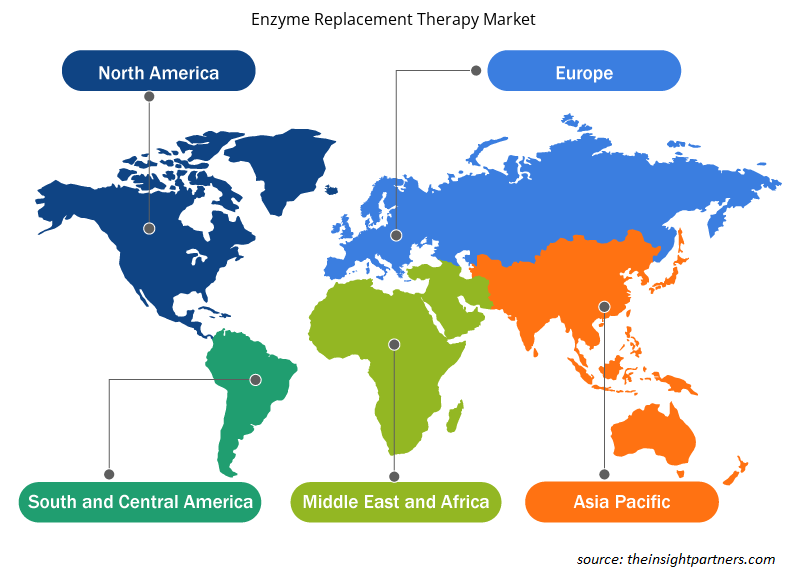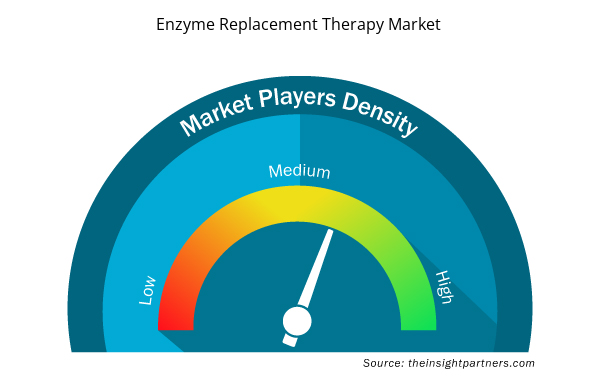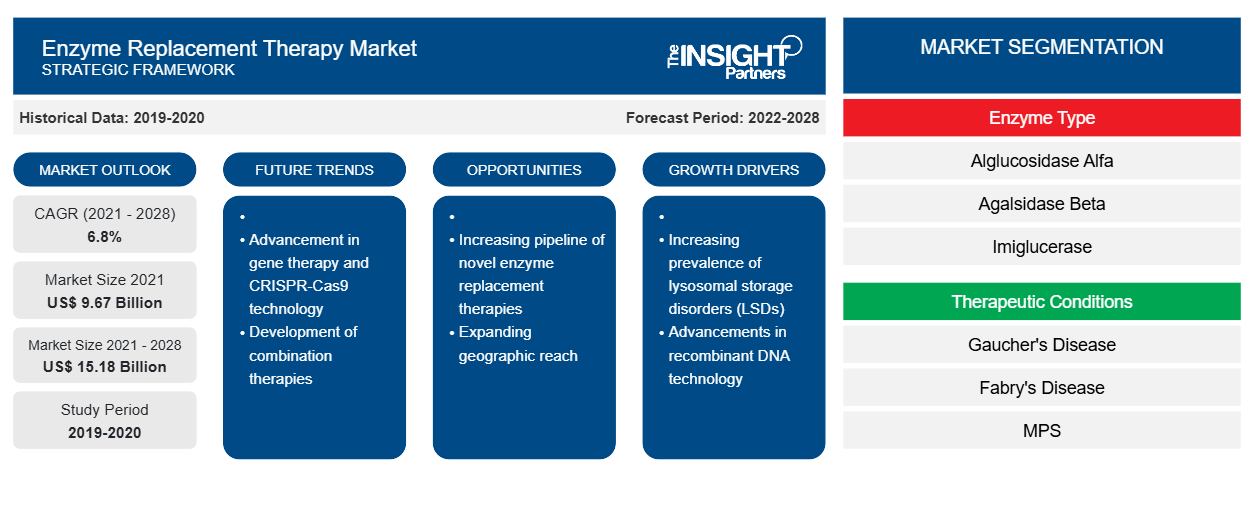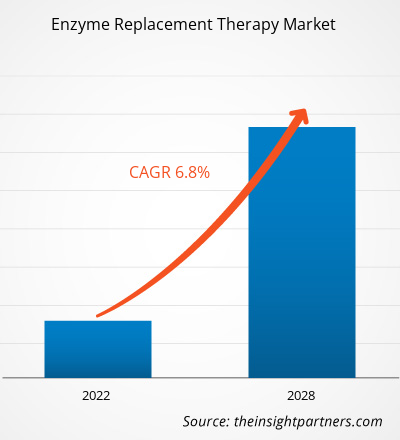Le marché de la thérapie de remplacement enzymatique devrait passer de 9 673,39 millions USD en 2021 à 15 184,70 millions USD en 2028 ; il devrait croître à un TCAC de 6,8 % de 2022 à 2028.
La thérapie de remplacement enzymatique ( ERT ) est réalisée pour traiter les déficiences enzymatiques congénitales en utilisant une enzyme ou une protéine ayant une activité enzymatique. Les enzymes animales, humaines et recombinantes sont quelques-unes des sources d'enzymes nécessaires au traitement. La thérapie est généralement appliquée aux maladies rares et de stockage lysosomal, notamment la maladie de Pompe , la maladie de Fabry , la maladie de Gaucher, la maladie de Tay-Sachs et le syndrome de Hurler. La méthode ERT la plus courante est la perfusion intraveineuse, dans laquelle l'enzyme de remplacement est administrée directement dans la circulation sanguine par un goutte-à-goutte contrôlé de liquides. La croissance du marché mondial de la thérapie de remplacement enzymatique est attribuée à la prévalence croissante des maladies de stockage lysosomal ( MLS ) et à l'approbation réglementaire rapide avec d'autres avantages marketing pour les médicaments ayant la désignation de médicament orphelin. Cependant, la concurrence acharnée entre les acteurs du marché freine la croissance du marché.
Le rapport offre des informations et une analyse approfondie du marché mondial de la thérapie de remplacement enzymatique, en mettant l'accent sur divers paramètres, notamment les tendances du marché, les avancées technologiques, la dynamique du marché et l'analyse du paysage concurrentiel des principaux acteurs du marché mondial. Il comprend également l'impact de la pandémie de COVID-19 sur le marché dans toutes les régions. En raison de la pandémie de COVID-19, de nombreuses autorités sanitaires se sont concentrées sur les soins liés à la pandémie. De plus, de nombreux patients nécessitant une thérapie de remplacement enzymatique ont manqué leurs perfusions en mars 2020 en raison de l'insuffisance des services hospitaliers face à la charge des patients COVID-19. Les patients nécessitant une ERT ont déclaré se sentir anxieux lors des admissions à l'hôpital ou concernant l'approvisionnement en médicaments. En outre, des études ont révélé que certains patients souffraient de dépression et d'une anxiété accrue. Ainsi, les séances programmées de thérapie de remplacement enzymatique ( ERT ) ont été perturbées pendant la pandémie de COVID-19, ce qui a eu un impact négatif sur le marché.
Personnalisez ce rapport en fonction de vos besoins
Vous bénéficierez d'une personnalisation gratuite de n'importe quel rapport, y compris de certaines parties de ce rapport, d'une analyse au niveau des pays, d'un pack de données Excel, ainsi que de superbes offres et réductions pour les start-ups et les universités.
- Obtenez les principales tendances clés du marché de ce rapport.Cet échantillon GRATUIT comprendra une analyse de données, allant des tendances du marché aux estimations et prévisions.
Informations basées sur la géographie
Sur le plan géographique, le marché mondial de la thérapie de remplacement enzymatique est segmenté en Amérique du Nord (États-Unis, Canada et Mexique), Europe (France, Allemagne, Royaume-Uni, Espagne, Italie et reste de l'Europe), Asie-Pacifique (Chine, Inde, Japon, Australie, Corée du Sud et reste de l' APAC ), Moyen-Orient et Afrique (Arabie saoudite, Émirats arabes unis , Afrique du Sud et reste de la région MEA ) et Amérique du Sud et centrale (Brésil, Argentine et reste de l'Amérique du Sud et centrale).
Informations sur le marché
Prévalence croissante des maladies de stockage lysosomal ( MSL )
Un lysosome est un organite cellulaire entouré d'une membrane qui contient des enzymes digestives . Un lysosome est le centre cellulaire clé pour le catabolisme , le recyclage et la signalisation des macromolécules . Tout défaut dans ces fonctions conduit à l'accumulation ou au stockage de macromolécules dans les lysosomes, ce qui entraîne des dommages cellulaires. La principale cause des maladies de stockage lysosomal ( MSL ) est la mutation des gènes responsables du codage d'une enzyme lysosomale. De plus, les MSL sont caractérisées comme une erreur métabolique innée qui entraîne l'absence ou la déficience d'une enzyme. Les nourrissons et les enfants souffrent plus gravement que les adultes, car les enfants peuvent hériter du gène défectueux d'un ou des deux parents. Cependant, depuis la dernière décennie, la tendance a changé et les MSL sont plus fréquentes chez les adultes
De plus, les troubles du stockage lysosomal concernent environ 70 maladies, dont la maladie de Gaucher, la maladie de Niemann-Pick, la maladie de Fabry, la maladie de Tay-Sachs, les mucopolysaccharidoses (MPS) et la maladie de Pompe. Ces troubles sont rares individuellement, mais collectivement, ils sont très répandus et touchent 1 naissance vivante sur 5 000. De nombreux pays ont mené des enquêtes pour comprendre le schéma de prévalence, et la prévalence globale était en hausse. Par exemple, une étude publiée dans The Lancet Regional Health intitulée « Prévalence des troubles de stockage lysosomal en Australie de 2009 à 2020 » a révélé les résultats suivants :
- La prévalence dans la population australienne est 1,6 fois supérieure (1 pour 4 800 naissances vivantes) à la prévalence signalée en 1996 (1 pour 7 700 naissances vivantes).
- La maladie de Fabry était la plus répandue, représentant 34 % de tous les diagnostics (jusqu'en 2020).
- Les LSD sont plus fréquents à l’âge adulte que dans l’enfance
Ainsi, la prévalence croissante des LSD et les thérapies limitées pour guérir la maladie stimulent la croissance du marché mondial des thérapies de remplacement enzymatique
Informations basées sur le type d'enzyme
En fonction du type d'enzyme, le marché mondial de la thérapie de remplacement enzymatique est segmenté en alglucosidase alfa, agalsidase bêta, imiglucérase, idursulfase, galsulfase, vélaglucérase alfa et autres enzymes. En 2021, le segment des autres enzymes représentait la plus grande part de marché. Le même segment devrait enregistrer le TCAC le plus élevé du marché de 2022 à 2028.
Informations basées sur les conditions thérapeutiques
En fonction des conditions thérapeutiques, le marché mondial de la thérapie de remplacement enzymatique est segmenté en maladie de Gaucher, maladie de Fabry , maladie de Pompe , SCID, MPS et autres conditions thérapeutiques. Le segment de la maladie de Gaucher détenait la plus grande part de marché en 2021 et devrait enregistrer le TCAC le plus élevé au cours de la période de prévision.
Informations basées sur la voie d'administration
En fonction de la voie d'administration, le marché mondial des thérapies de remplacement enzymatiques est divisé en deux catégories : parentérale et orale. Le segment parentéral détenait une part de marché plus importante en 2021 et devrait enregistrer un TCAC plus élevé au cours de la période de prévision.
Aperçu régional du marché de la thérapie de remplacement enzymatique
Les tendances régionales et les facteurs influençant le marché de la thérapie de remplacement enzymatique tout au long de la période de prévision ont été expliqués en détail par les analystes d’Insight Partners. Cette section traite également des segments et de la géographie du marché de la thérapie de remplacement enzymatique en Amérique du Nord, en Europe, en Asie-Pacifique, au Moyen-Orient et en Afrique, ainsi qu’en Amérique du Sud et en Amérique centrale.

- Obtenez les données régionales spécifiques au marché de la thérapie de remplacement enzymatique
Portée du rapport sur le marché de la thérapie de remplacement enzymatique
| Attribut de rapport | Détails |
|---|---|
| Taille du marché en 2021 | 9,67 milliards de dollars américains |
| Taille du marché d'ici 2028 | 15,18 milliards de dollars américains |
| Taux de croissance annuel moyen mondial (2021-2028) | 6,8% |
| Données historiques | 2019-2020 |
| Période de prévision | 2022-2028 |
| Segments couverts | Par type d'enzyme
|
| Régions et pays couverts | Amérique du Nord
|
| Leaders du marché et profils d'entreprises clés |
|
Densité des acteurs du marché de la thérapie de remplacement enzymatique : comprendre son impact sur la dynamique commerciale
Le marché des thérapies de remplacement enzymatique connaît une croissance rapide, tirée par la demande croissante des utilisateurs finaux en raison de facteurs tels que l'évolution des préférences des consommateurs, les avancées technologiques et une plus grande sensibilisation aux avantages du produit. À mesure que la demande augmente, les entreprises élargissent leurs offres, innovent pour répondre aux besoins des consommateurs et capitalisent sur les tendances émergentes, ce qui alimente davantage la croissance du marché.
La densité des acteurs du marché fait référence à la répartition des entreprises ou des sociétés opérant sur un marché ou un secteur particulier. Elle indique le nombre de concurrents (acteurs du marché) présents sur un marché donné par rapport à sa taille ou à sa valeur marchande totale.
Les principales entreprises opérant sur le marché de la thérapie de remplacement enzymatique sont :
- Sanofi
- BioMarin Pharmaceutique Inc.
- Société pharmaceutique Takeda Limited
- AbbVie Inc.
- Janssen Pharmaceuticals (Johnson & Johnson Services, Inc.)
Avis de non-responsabilité : les sociétés répertoriées ci-dessus ne sont pas classées dans un ordre particulier.

- Obtenez un aperçu des principaux acteurs du marché de la thérapie de remplacement enzymatique
Informations basées sur l'utilisateur final
En fonction de l'utilisateur final, le marché mondial de la thérapie de remplacement enzymatique est segmenté en hôpitaux, centres de perfusion et autres. Le segment des hôpitaux détenait la plus grande part de marché en 2021. Cependant, le segment des centres de perfusion devrait enregistrer le TCAC le plus élevé au cours de la période de prévision.
Les acteurs du marché mondial de la thérapie enzymatique substitutive adoptent des stratégies organiques, notamment le lancement et l'expansion de produits, pour étendre leur empreinte et leur portefeuille de produits dans le monde entier et répondre à la demande croissante. Quelques acteurs majeurs contribuant au marché sont Takeda Pharmaceutical Company Limited ; Sanofi SA ; AbbVie Inc. ; BioMarin Pharmaceutical Inc. ; Amicus Therapeutics ; Alexion Pharmaceuticals, Inc. (AstraZeneca) ; Janssen Pharmaceuticals (Johnson & Johnson Services, Inc.) ; Recordati SpA ; Pfizer Inc. ; et CHIESI Farmaceutici SpA
- Analyse historique (2 ans), année de base, prévision (7 ans) avec TCAC
- Analyse PEST et SWO
- Taille du marché Valeur / Volume - Mondial, Régional, Pays
- Industrie et paysage concurrentiel
- Ensemble de données Excel



Report Coverage
Revenue forecast, Company Analysis, Industry landscape, Growth factors, and Trends

Segment Covered
This text is related
to segments covered.

Regional Scope
North America, Europe, Asia Pacific, Middle East & Africa, South & Central America

Country Scope
This text is related
to country scope.
Questions fréquemment posées
Global enzyme replacement therapy market is segmented by region into North America, Europe, Asia Pacific, Middle East & Africa, and South & Central America. In North America, the U.S. is the largest market for enzyme replacement therapy market. A rise in the prevalence of lysosomal storage diseases such as Gaucher’s, Pompe’s, and Fabry’s diseases, increasing regulatory approval, favorable regulatory support by the government, and the availability of various ERT products will drive enzyme replacement therapy market growth in North America. However, the growing government funding for rare disease treatment, increasing clinical trials, an increasing number of product approvals, and expanding partnerships among key players are the key factors responsible for the Asia-Pacific regional growth of the enzyme replacement therapy market accounting fastest growth in the region during the coming years.
The hospitals segment dominated the global enzyme replacement therapy market and accounted for the largest market share of 49.00% in 2021.
Takeda Pharmaceutical Company Limited, Sanofi, AbbVie Inc., BioMarin Pharmaceutical Inc., Amicus Therapeutics, Alexion Pharmaceuticals, Inc.(AstraZeneca), Janssen Pharmaceuticals (Johnson & Johnson Services, Inc.), Recordati S.p.A., Pfizer Inc., and CHIESI Farmaceutici S.p.A. are among the leading companies operating in the enzyme replacement therapy market
Based on route of administration, parenteral route of administration segment took the forefront lead in the worldwide market by accounting largest share in 2021 and is expected to continue to do so till the forecast period.
Based on therapeutic conditions, Gaucher's disease segment took the forefront lead in the worldwide market by accounting largest share in 2021 and is expected to continue to do so till the forecast period.
Based on enzyme type, other enzymes segment took the forefront lead in the worldwide market by accounting largest share in 2021 and is expected to continue to do so till the forecast period. Other enzymes include taliglucerase, laronidase, agalsidase alfa, eliglustat, cipaglucosidase alfa, miglustat, elosulfase alfa, elapegademase, velmanase alfa, pancreatic enzymes, pegademase, sebelipase alfa, cerliponase alfa, among others.
Enzyme replacement therapy (ERT) is a treatment that replaces enzymes that are not present or are deficient in the body. This is usually done by giving the patient an intravenous (IV) infusion or oral solution in which the enzyme is present. ERT is available for various lysosomal storage diseases which include Fabry’s disease, Gaucher’s disease, Pompe’s disease, MPS, and others. The ERT only increases the concentration of the enzymes which is lacking in the patient body and it does not correct any underlying genetic defect. ERT has also been used to treat patients with severe combined immunodeficiency (SCID) resulting from an adenosine deaminase deficiency (ADA-SCID).
Rising prevalence of lysosomal storage diseases (LSDS) and rapid regulatory approval with other benefits for drug with orphan drug designation are the most significant factors responsible for the overall market growth.
Trends and growth analysis reports related to Life Sciences : READ MORE..
The List of Companies - Enzyme Replacement Therapy Market
- Sanofi
- BioMarin Pharmaceutical Inc.
- Takeda Pharmaceutical Company Limited
- AbbVie Inc.
- Janssen Pharmaceuticals (Johnson & Johnson Services, Inc.)
- Alexion Pharmaceuticals, Inc (AstraZeneca)
- Amicus Therapeutics
- Recordati S.p.A.
- CHIESI Farmaceutici S.p.A.
- Pfizer Inc.
The Insight Partners performs research in 4 major stages: Data Collection & Secondary Research, Primary Research, Data Analysis and Data Triangulation & Final Review.
- Data Collection and Secondary Research:
As a market research and consulting firm operating from a decade, we have published and advised several client across the globe. First step for any study will start with an assessment of currently available data and insights from existing reports. Further, historical and current market information is collected from Investor Presentations, Annual Reports, SEC Filings, etc., and other information related to company’s performance and market positioning are gathered from Paid Databases (Factiva, Hoovers, and Reuters) and various other publications available in public domain.
Several associations trade associates, technical forums, institutes, societies and organization are accessed to gain technical as well as market related insights through their publications such as research papers, blogs and press releases related to the studies are referred to get cues about the market. Further, white papers, journals, magazines, and other news articles published in last 3 years are scrutinized and analyzed to understand the current market trends.
- Primary Research:
The primarily interview analysis comprise of data obtained from industry participants interview and answers to survey questions gathered by in-house primary team.
For primary research, interviews are conducted with industry experts/CEOs/Marketing Managers/VPs/Subject Matter Experts from both demand and supply side to get a 360-degree view of the market. The primary team conducts several interviews based on the complexity of the markets to understand the various market trends and dynamics which makes research more credible and precise.
A typical research interview fulfils the following functions:
- Provides first-hand information on the market size, market trends, growth trends, competitive landscape, and outlook
- Validates and strengthens in-house secondary research findings
- Develops the analysis team’s expertise and market understanding
Primary research involves email interactions and telephone interviews for each market, category, segment, and sub-segment across geographies. The participants who typically take part in such a process include, but are not limited to:
- Industry participants: VPs, business development managers, market intelligence managers and national sales managers
- Outside experts: Valuation experts, research analysts and key opinion leaders specializing in the electronics and semiconductor industry.
Below is the breakup of our primary respondents by company, designation, and region:

Once we receive the confirmation from primary research sources or primary respondents, we finalize the base year market estimation and forecast the data as per the macroeconomic and microeconomic factors assessed during data collection.
- Data Analysis:
Once data is validated through both secondary as well as primary respondents, we finalize the market estimations by hypothesis formulation and factor analysis at regional and country level.
- Macro-Economic Factor Analysis:
We analyse macroeconomic indicators such the gross domestic product (GDP), increase in the demand for goods and services across industries, technological advancement, regional economic growth, governmental policies, the influence of COVID-19, PEST analysis, and other aspects. This analysis aids in setting benchmarks for various nations/regions and approximating market splits. Additionally, the general trend of the aforementioned components aid in determining the market's development possibilities.
- Country Level Data:
Various factors that are especially aligned to the country are taken into account to determine the market size for a certain area and country, including the presence of vendors, such as headquarters and offices, the country's GDP, demand patterns, and industry growth. To comprehend the market dynamics for the nation, a number of growth variables, inhibitors, application areas, and current market trends are researched. The aforementioned elements aid in determining the country's overall market's growth potential.
- Company Profile:
The “Table of Contents” is formulated by listing and analyzing more than 25 - 30 companies operating in the market ecosystem across geographies. However, we profile only 10 companies as a standard practice in our syndicate reports. These 10 companies comprise leading, emerging, and regional players. Nonetheless, our analysis is not restricted to the 10 listed companies, we also analyze other companies present in the market to develop a holistic view and understand the prevailing trends. The “Company Profiles” section in the report covers key facts, business description, products & services, financial information, SWOT analysis, and key developments. The financial information presented is extracted from the annual reports and official documents of the publicly listed companies. Upon collecting the information for the sections of respective companies, we verify them via various primary sources and then compile the data in respective company profiles. The company level information helps us in deriving the base number as well as in forecasting the market size.
- Developing Base Number:
Aggregation of sales statistics (2020-2022) and macro-economic factor, and other secondary and primary research insights are utilized to arrive at base number and related market shares for 2022. The data gaps are identified in this step and relevant market data is analyzed, collected from paid primary interviews or databases. On finalizing the base year market size, forecasts are developed on the basis of macro-economic, industry and market growth factors and company level analysis.
- Data Triangulation and Final Review:
The market findings and base year market size calculations are validated from supply as well as demand side. Demand side validations are based on macro-economic factor analysis and benchmarks for respective regions and countries. In case of supply side validations, revenues of major companies are estimated (in case not available) based on industry benchmark, approximate number of employees, product portfolio, and primary interviews revenues are gathered. Further revenue from target product/service segment is assessed to avoid overshooting of market statistics. In case of heavy deviations between supply and demand side values, all thes steps are repeated to achieve synchronization.
We follow an iterative model, wherein we share our research findings with Subject Matter Experts (SME’s) and Key Opinion Leaders (KOLs) until consensus view of the market is not formulated – this model negates any drastic deviation in the opinions of experts. Only validated and universally acceptable research findings are quoted in our reports.
We have important check points that we use to validate our research findings – which we call – data triangulation, where we validate the information, we generate from secondary sources with primary interviews and then we re-validate with our internal data bases and Subject matter experts. This comprehensive model enables us to deliver high quality, reliable data in shortest possible time.


 Obtenez un échantillon gratuit pour ce rapport
Obtenez un échantillon gratuit pour ce rapport